Sleep Apnea and Sleep
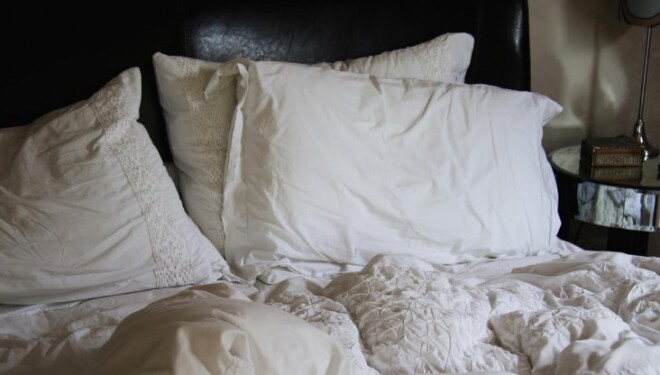
Sleep Apnea Guide: Causes, Symptoms and Treatment Options
[toc heading_levels="3,4,5,6"]
What is sleep apnea?
Sleep apnea is a common and potentially serious sleep disorder in which your breathing is repeatedly interrupted while you sleep. If left untreated, sleep apnea can contribute to type 2 diabetes and heart disease while increasing your likelihood of stroke and heart attack.
Sleep apnea can affect toddlers, children, and adults, although some of the identifying symptoms are different depending on your age.
Obstructive sleep apnea is a disorder in which breathing is briefly and repeatedly interrupted during sleep. The "apnea" in sleep apnea refers to a breathing pause that lasts at least ten seconds. Obstructive sleep apnea occurs when the muscles in the back of the throat fail to keep the airway open, despite efforts to breathe. Another form of sleep apnea is central sleep apnea, in which the brain fails to properly control breathing during sleep. Obstructive sleep apnea is far more common than central sleep apnea.
Obstructive sleep apnea, or simply sleep apnea, can cause fragmented sleep and low blood oxygen levels. For people with sleep apnea, the combination of disturbed sleep and oxygen starvation may lead to hypertension, heart disease and mood and memory problems. Sleep apnea also increases the risk of automobile crashes. Sleep apnea can be life-threatening and you should consult your doctor immediately if you feel you may suffer from it.
More than 18 million American adults have sleep apnea. It is very difficult at present to estimate the prevalence of childhood OSA because of widely varying monitoring techniques, but a minimum prevalence of 2 to 3% is likely, with prevalence as high as 10 to 20% in habitually snoring children.
OSA occurs in all age groups and both sexes, but there are a number of factors that increase risk, including having a small upper airway (or large tongue, tonsils or uvula), being overweight, having a recessed chin, small jaw or a large overbite, a large neck size (17 inches or greater in a man, or 16 inches or greater in a woman), smoking and alcohol use, being age 40 or older, and ethnicity (African-Americans, Pacific-Islanders and Hispanics). Also, OSA seems to run in some families, suggesting a possible genetic basis.
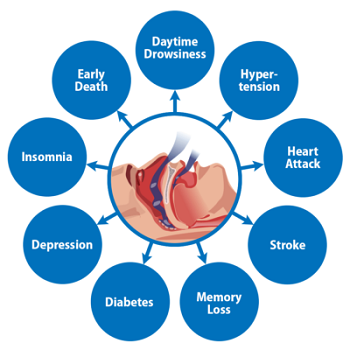
Symptoms of Sleep Apnea
Chronic snoring is a strong indicator of sleep apnea and should be evaluated by a health professional. Since people with sleep apnea tend to be sleep deprived, they may suffer from sleeplessness and a wide range of other symptoms such as difficulty concentrating, depression, irritability, sexual dysfunction, learning and memory difficulties, and falling asleep while at work, on the phone, or driving.
Left untreated, symptoms of sleep apnea can include disturbed sleep, excessive sleepiness during the day, high blood pressure, heart attack, congestive heart failure, cardiac arrhythmia, stroke or depression.
The most common symptom of sleep apnea is snoring. However, not everyone who snores has sleep apnea. Snoring is likely to be a sign of sleep apnea when it is followed by silent breathing pauses and choking or gasping sounds.
People with sleep apnea often have daytime sleepiness or fatigue.
Common symptoms of sleep apnea include:
- Loud or frequent snoring
- Silent pauses in breathing
- Choking or gasping sounds
- Daytime sleepiness or fatigue
- Unrefreshing sleep
- Insomnia
- Morning headaches
- Nocturia (waking during the night to go to the bathroom)
- Difficulty concentrating
- Memory loss
- Decreased sexual desire
- Irritability
7 General signs of sleep apnea
Snoring
Loud, chronic snoring is one of the most frequently cited symptoms of sleep apnea. Snoring is the sound produced by vibrations in the upper respiratory airways during sleep. It is caused by partial blockage or obstructions as air is being restricted from moving easily through the airways.
Many people who snore may not even be aware that they do so and are only alerted to it by an annoyed bedpartner whose sleep is disturbed due to the loud noises coming from the other side of the bed. While snoring is a common symptom of sleep apnea, it doesn't necessarily indicate that the person has the disorder. Many people who snore don't have sleep apnea, and some people with sleep apnea don't snore.
However, if your snoring is loud, disruptive, and occurs on a nightly basis, it could very well be a sign of sleep apnea, and you may want to discuss your snoring with your primary care physician to see if it may be sleep apnea.
Frequent breaks or pauses in breathing
In obstructive sleep apnea, the fatty tissues of the throat or tongue become relaxed during sleep and fall back into your airways which restricts airflow and causes you to stop breathing for a few seconds. During an apnea event, the oxygen levels in your blood drop. This causes your brain to wake itself from sleep long enough jump start your respiratory system into working properly again and get air past the blockage.
While your brain partially wakes up to respond to the interruption in breathing, you still remain mostly asleep without realizing that you partially awoke. But while you may not realize that you frequently wake during sleep, the constant interruptions have a negative impact on the amount and quality of sleep you get which lead to many of the other symptoms on this list.
Apnea events can occur anywhere between 5 to 30 times in an hour lasting up to 10-20 seconds at a time. Those with severe obstructive sleep apnea can experience hundreds of apnea events a night. If you've been told that you frequently stop breathing in your sleep, it's time to talk with your doctor or schedule an appointment with a sleep specialist.
You're Tired all the Time
While you may think you got plenty of sleep during the night because you were in bed for 7-9 hours overnight, all of those pauses and interruptions to your sleep add up to a lot of lost time in quality and quantity of nightly sleep. One of the most common (but frequently overlooked) symptoms of sleep apnea is excessive daytime sleepiness (EDS). EDS is characterized by a chronic feeling of overwhelming daytime fatigue.
Common symptoms of EDS are: difficulty waking in the mornings, feeling excessively tired all day long, a general lack of energy, needing or taking frequent naps that only partially (or not at all) relieve symptoms, dozing off at inappropriate times, and difficulty concentrating among others.
Daytime drowsiness can even lead to serious accidents or even death especially if the sufferer is driving or working on or around heavy equipment or machines.
You frequently wake with headaches
Headaches are commonly reported by sufferers of sleep apnea. As you stop breathing frequently during the night, less oxygen is making its way to your brain. Low oxygen levels initiate the widening of blood vessels and can cause vascular headaches.
Along with excessive daytime drowsiness, headaches are usually the symptoms that sleep apnea sufferers complain the most about as they may not be aware that they have symptoms of snoring or breaks in breathing.
You Have High Blood Pressure
Hypertension is commonly linked to sleep apnea. For the same reasons you experience headaches due to frequent pauses during sleep, you can get high blood pressure. As your brain wakes from sleep as it realizes that its not receiving adequate oxygen levels in the blood it causes a spike in blood pressure as it restricts your blood vessels to kick starts your system into working again.
When this happens repeatedly throughout the night to combat every apnea event, your body gets used to having to restrict its blood vessels and high blood pressure begins to persist even during the day when you are breathing normally.
You are overweight or obese
In many cases a person's body weight is directly linked to having obstructive sleep apnea. People who are overweight or obese are more likely to have sleep apnea than those that maintain healthy weights. Sleep apnea can often be caused by excess fatty tissues that become built up in the neck and throat.
- The excess tissues can fall back into the airways during sleep causing obstructions to the airways and leading to apnea events. If your neck circumference is greater than 17 inches for men or 16 inches for women you have a higher risk of sleep apnea due to fatty tissue buildup surrounding your airways which can cause restrictions in breathing during sleep.
You are often irritable, depressed, or experience mood swings.
Lack of quality sleep can affect a person's mood. Losing sleep nearly every night can make you more irritable, prone to anxiety, short-tempered, and over a long enough time even depressed. If you think your mood swings or depression may be caused by a lack of sleep contact your primary care physician to see if it's related to a sleep disorder.
If you have experienced any of the previous symptoms it may be time to contact a sleep specialist to schedule a sleep study. Left untreated, sleep apnea can cause a whole slew of medical problems and can put you at an increased risk for many health issues including: heart failure, arrhythmias, gastroesophageal reflux disease, diabetes, stroke, and heart attacks.
At the Alaska Sleep Clinic we diagnose and treat thousands of cases of sleep apnea every year. Because treatment for sleep apnea through continuous positive airway pressure (CPAP) therapy or other alternative treatments is so effective, there's no reason to have to live with sleep apnea or any of its debilitating symptoms.
For a free 10 minute phone consultation with a sleep expert click the link below and be on your way to getting quality sleep every night so you feel energized everyday.
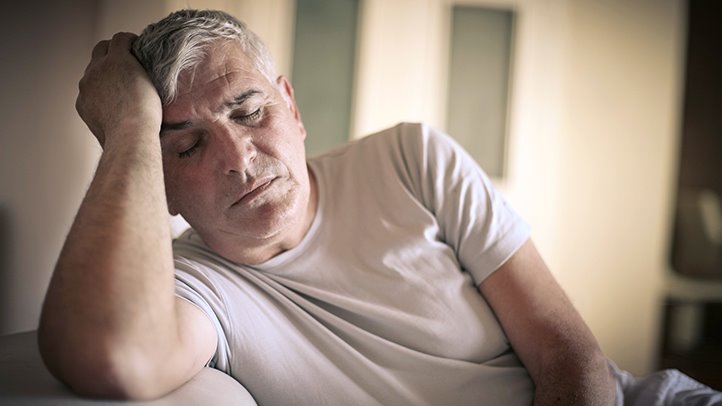
Signs and symptoms of sleep apnea in adults
If a number of these 13 signs describe you, then there’s a good chance you may have sleep apnea.
- You snore loudly.
- Your bed partner says that you snore and sometimes stop breathing when you sleep.
- You sometimes wake up abruptly with shortness of breath.
- You sometimes wake up choking or gasping.
- You often wake up to use the bathroom.
- You wake up with a dry mouth or sore throat.
- You often wake up with a headache.
- You have insomnia (difficulty staying asleep).
- You have hypersomnia (excessive daytime sleepiness).
- You have attention, concentration, or memory problems while awake.
- You are irritable and experience mood swings.
- You have risk factors for sleep apnea, such as being overweight or obese, drinking alcohol, or smoking tobacco.
- You have a decreased interest in sex or are experiencing sexual dysfunction.
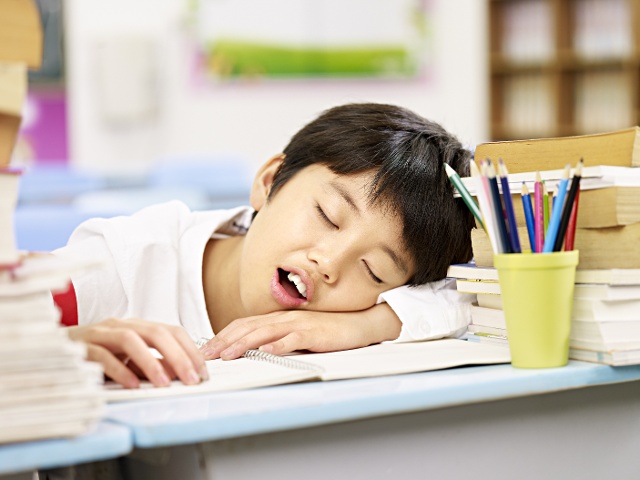
Signs of sleep apnea in Children
According to Johns Hopkins Medicine, 10 to 20 percent of children who snore may have sleep apnea. Overall, an estimated 3 percent of children have sleep apnea.
Many children with untreated sleep apnea have behavioral, adaptive, and learning issues that are similar to the symptoms of ADHD:
- difficulty with learning
- poor attention span
- poor performance at school
Look for these warning signs of sleep apnea in your child:
- snoring
- mouth breathing (while asleep and awake)
- breathing pauses during sleep
- bedwetting
- daytime sleepiness
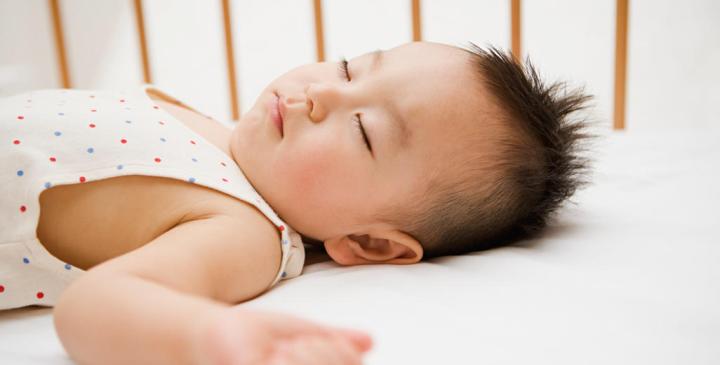
Signs of sleep apnea in toddlers
If you think your toddler may have a sleep disorder, look for these warning signs of sleep apnea while they’re sleeping:
- snoring and difficulty breathing
- pauses in breathing
- restlessness
- coughing or choking
- sweating profusely
You can also look for the following signs while they’re awake:
- prone to irritability, crankiness, and frustration
- falling asleep at inappropriate times
- tonsil- or adenoid-related health problems
- growing more slowly than they should (both height and weight)
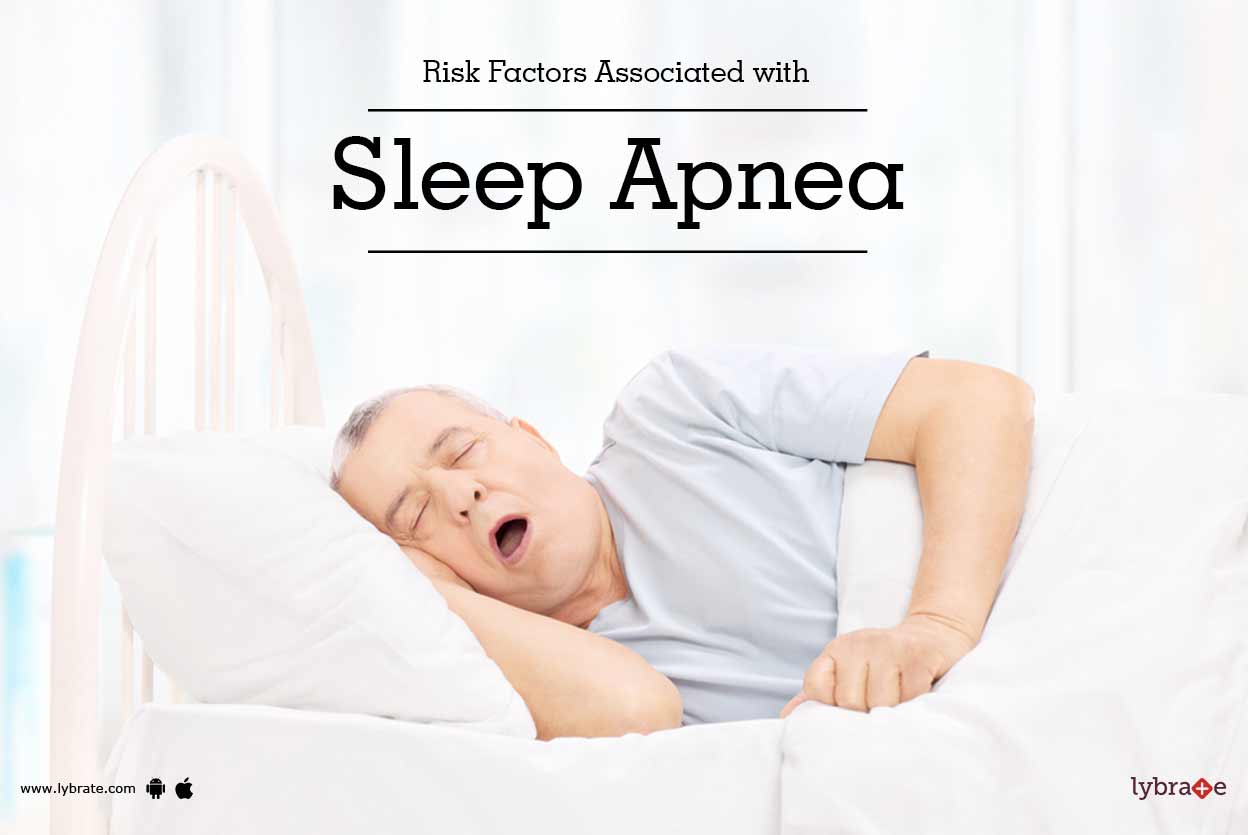
Risk Factors
The major risk factor for sleep apnea is excess body weight. You are much more likely to have sleep apnea if you are overweight or obese. However, sleep apnea can occur in slim people too. Common risk factors for sleep apnea include:
- Excess weight – Your risk for sleep apnea is higher if you are overweight with a body mass index (BMI) of 25 or more or obese with a BMI of 30 or higher.
- Large neck size - Your risk for sleep apnea is higher if you have a neck size of 17 inches or more for men, or 16 inches or more for women. A large neck has more soft tissue that can block your airway during sleep.
- Middle age – Sleep apnea can occur at any age. However, it is more common between young adulthood and middle age.
- Male gender – Sleep apnea is more common in men than in women. For women the risk of sleep apnea increases with menopause.
- Hypertension – High blood pressure is extremely common in people who have sleep apnea.
- Family history – Sleep apnea is a heritable condition. This means that you have a higher risk of sleep apnea if a family member also has it. Inherited traits that increase the risk for sleep apnea include obesity and physical features such as a recessed jaw. Other common family factors - such as physical activity and eating habits - also may play a role.
Why is Sleep Apnea dangerous?
Snoring may seem comical, but Obstructive Sleep Apnea is no joke. It can increase your risk of high blood pressure or diabetes and even make you more dangerous on the road.
Here are seven health problems are linked to obstructive Sleep Apnea:
- High blood pressureObstructive Sleep Apnea can contribute to high blood pressure in people who have it. The frequent night time wakings that plague people with Sleep Apnea cause hormonal systems to go into overdrive, which results in high blood pressure levels at night. Low blood-oxygen levels, caused by the cutoff of oxygen, may also contribute to hypertension in people with Sleep Apnea. Some good news … some people with high blood pressure who are treated for Sleep Apnea can cut back on their blood pressure medications. Read More: How Sleep Apnea Affects Blood Pressure
- Heart diseasePeople with obstructive Sleep Apnea are more likely to suffer heart attacks and even die in the middle of the night. The causes may be low oxygen or the stress of waking up often during sleep. Stroke and atrial fibrillation – a problem with the rhythm of the heartbeat - is also associated with obstructive Sleep Apnea. The disrupted oxygen flow caused by Sleep Apnea makes it hard for your brain to regulate the flow of blood in arteries and the brain itself. Read more: Sleep Apnea and Heart Disease
- Sleep Apnea is very common among people with type 2 diabetes – up to 80% of diabetics have some obstructive Sleep Apnea. Obesity is a common risk factor for both disorders. Although studies haven’t shown a clear link between Sleep Apnea alone and type 2 diabetes, sleep deprivation can cause insulin resistance, a precursor to diabetes. Read more: The Link Between a Lack of Sleep and Type 2 Diabetes
- Weight gainAdding weight raises your risk of Sleep Apnea, with up to two-thirds of people with Sleep Apnea severely overweight. Obstructive Sleep Apnea can often be cured if you lose enough weight, but that can be tough to do. Read more: Losing Weight with Sleep Apnea
Being overweight causes fatty deposits in the neck that block breathing at night. In turn, Sleep Apnea impairs the body’s endocrine systems, causing the release of the hormone ghrelin, which makes you crave carbohydrates and sweets. Also, people with Sleep Apnea who are tired and sleepy all the time may have a lower metabolism, which can also contribute to weight gain. Getting treatment for Sleep Apnea can make you feel better, with more energy for exercise and other activities. - Adult asthma.Although the link to obstructive Sleep Apnea is not proven, people who are treated may find they have fewer asthma attacks. Read more : Asthma and Sleep
- Acid reflux.There’s no proof that Sleep Apnea causes acid reflux, persistent heartburn, but many people complain of acid reflux, and treating it seems to improve Sleep Apnea symptoms, say sleep physicians. Read more: Gastroesophogeal Reflux Disease (GERD)
- Car accidents.Daytime tiredness can put people with Sleep Apnea at increased risk of falling asleep behind the wheel. People with Sleep Apnea are up to five times more likely than normal sleepers to have traffic accidents. See more Car accidents
Treatment
If you suspect you may have sleep apnea, the first thing to do is see your doctor. Bring with you a record of your sleep, fatigue levels throughout the day, and any other symptoms you might be having. Ask your bed partner if he or she notices that you snore heavily, choke, gasp, or stop breathing during sleep. Be sure to take an updated list of medications, including over the counter medications, with you any time you visit a doctor for the first time. You may want to call your medical insurance provider to find out if a referral is needed for a visit to a sleep center.
One of the most common methods used to diagnose sleep apnea is a sleep study, which may require an overnight stay at a sleep center. The sleep study monitors a variety of functions during sleep including sleep state, eye movement, muscle activity, heart rate, respiratory effort, airflow, and blood oxygen levels. This test is used both to diagnose sleep apnea and to determine its severity. Sometimes, treatment can be started during the first night in the sleep center.
The treatment of choice for obstructive sleep apnea is continuous positive airway pressure device (CPAP). CPAP is a mask that fits over the nose and/or mouth, and gently blows air into the airway to help keep it open during sleep. This method of treatment is highly effective. Using the CPAP as recommended by your doctor is very important.
Second-line methods of treating sleep apnea include dental appliances, which reposition the lower jaw and tongue, and upper airway surgery to remove tissue in the airway. In general, these approaches are most helpful for mild disease or heavy snoring.
Lifestyle changes are effective ways of mitigating symptoms of sleep apnea. Here are some tips that may help reduce apnea severity:
- Lose weight. If you are overweight, this is the most important action you can take to cure your sleep apnea (CPAP only treats it; weight loss can cure it in the overweight person).
- Avoid alcohol; it causes frequent nighttime awakenings, and makes the upper airway breathing muscles relax.
- Quit smoking. Cigarette smoking worsens swelling in the upper airway, making apnea (and snoring) worse.
- Some patients with mild sleep apnea or heavy snoring have fewer breathing problems when they are lying on their sides instead of their backs.
Coping
The most important part of treatment for people with OSA is using the CPAP whenever they sleep. The health benefits of this therapy can be enormous, but only if used correctly. If you are having problems adjusting your CPAP or you're experiencing side effects of wearing the appliance, talk to the doctor who prescribed it and ask for assistance.
Getting adequate sleep is essential to maintaining health in OSA patients. If you have symptoms of insomnia such as difficulty falling asleep, staying asleep, or waking up unrefreshed, talk to your doctor about treatment options. Keep in mind that certain store-purchased and prescription sleep aids may impair breathing in OSA patients. One exception is ramelteon, which was studied in mild and moderate OSA patients and found to not harm their breathing.
Poll Data
In the 2005 Sleep in America poll, 8% of respondents experienced or had been observed having pauses in their breathing during sleep at least three nights per week. Adults in the poll were also given the Berlin questionnaire, a standardized test assessing risk for sleep apnea.
Based on the quetionnaire, 26% of all poll respondents were at risk. Of those at risk, 70% said that they snored, slept on average 6.4 hours/weeknight (compared to overall mean of 6.8 hours); 66% were experiencing daytime sleepiness at least 3 days per week and over half (58%) were obese.
Of adults in this population who had been diagnosed with high blood pressure or depression, almost half were also at risk for sleep apnea. 33% of those who drink 4 or more caffeinated beverages daily are designated at risk for sleep apnea.
Reviewed by Barbara Phillips, M.D., M.S.P.H.
Learn more about how these medical devices can make a big difference in nighttime comfort for people with breathing issues.Sleep Apnea is a sleep disorder in which breathing is briefly and repeatedly interrupted during sleep. Learn how to cope with this sleep-related breathing disorder.A frequent need to get up and go to the bathroom to urinate at night is called nocturia. It differs...Nearly one-quarter of all workers have shifts that are not during the daytime, and more than two-thirds of these workers...
You don't have to struggle with sleepless nights. Help is available! There are treatment options for insomnia, ranging from behavioral...How you feel about the sleep you get every night is known as sleep satisfaction. Unlike sleep quantity (which objectively...For many parents, the word “tired” takes on new meaning during the first few weeks after bringing a baby home....
Sometimes snoring can sound like a light rustle. Other nights, it would seem there was an actual buzz saw under...Many people realize that their level of hydration can affect the way they feel and function throughout the day. A...Taking a road trip is an exciting way to travel, but make sure that sleep is on the agenda. Drowsy...
Source: Internet





